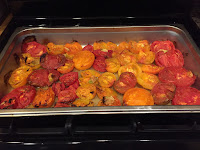Why Cleanup Still Matters
Some plant debris harbors pests and pathogens that overwinter in our climate. Powdery mildew can persist on cucurbits and peonies; tomato blight can linger in stems and fallen fruit; rust fungi hang on in hollyhock stalks. Insects like squash bugs and grasshoppers survive in crop debris or soil. If this material remains, it becomes a ready source of infection or infestation in spring. Removing diseased or infested debris in fall reduces inoculum and pest pressure for the following season.
What about composting?
Most plant pathogens are inactivated at sustained hot-compost temperatures around 131–140°F for several days. However, many weed seeds and tougher pathogens need higher and longer exposure—often 150–160°F with thorough turning so all materials pass through the hot core. If your backyard pile doesn’t reliably reach and hold those temps, it’s safest to bag diseased plants and noxious weeds rather than compost them.
Why We Also “Leave the Leaves”
At the same time, many beneficial insects and birds depend on fall’s “messiness.” Research and field observations show that native bees and other insects overwinter in hollow or pithy stems and within leaf litter. Seed heads from plants like coneflower, rudbeckia, and native grasses feed birds through winter. Decomposing leaves improve soil structure and organic matter—especially helpful in our typically lean, alkaline Intermountain soils.
Finding the Balance
Think “tidy where you must, messy where you can.”
Remove: Blight-infected tomato vines, mildew-covered cucurbits, rusted stalks, and obviously infested material. Dispose rather than compost unless your pile truly runs hot and is turned.
Leave: Healthy seed heads and stems for winter structure, food, and habitat. A thin layer of leaves beneath shrubs, trees, and perennials helps insulate soil and shelter beneficials.Modify: Clear leaves from lawns and hardscapes to prevent turf smothering and slick surfaces, but keep some in beds and wild corners.
Local Timing Tips
Wait for dormancy before major cutback—typically late October into November. Leaves retained under woody plants conserve soil moisture through our dry winters. In early spring, cut back the stems you left standing before new growth begins; by then, most overwintering insects have emerged.
Takeaway
“Leave the Leaves” and fall cleanup aren’t opposites—they’re complementary. Remove the problem material; keep the habitat. That balance supports pollinators, birds, soil life, and a healthier garden next season.
Resources:
https://blog.nwf.org/2024/09/how-fallen-leaves-support-moths-and-butterflies
https://www.usda.gov/about-usda/news/blog/fall-leave-leaves
https://www.nwf.org/Home/Latest-News/Press-Releases/2025/9-16-2025-Leave-the-Leaves-Survey












.png)